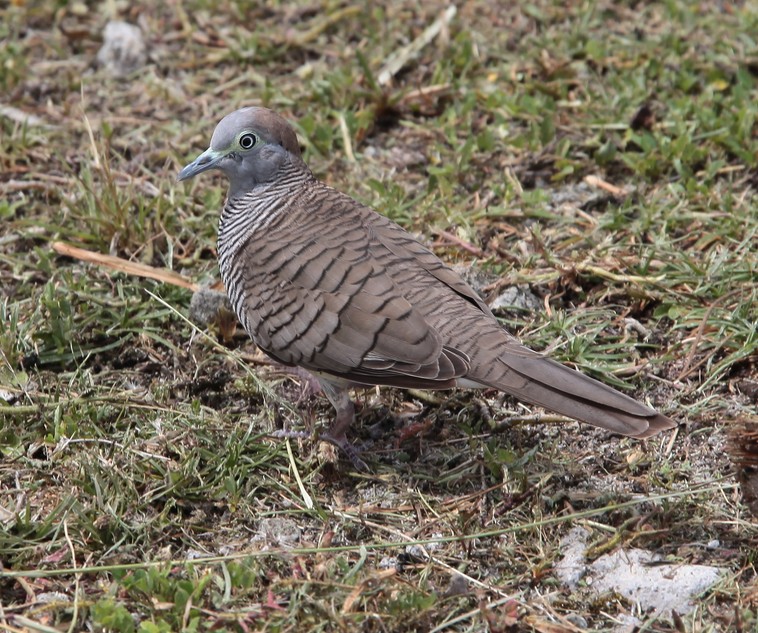GEOPELIA STRIATA - (LINNAEUS, 1766)
La Géopélie zébrée ou Colombine zébrée (Geopelia striata) est un columbidé d'une vingtaine de centimètres.
Description
La Géopélie zébrée est une petite tourterelle. Sa tête est gris bleu pâle. Le dessus du corps est gris brun clair. Toutes les plumes du cou aux sus-caudales sont marquées d'une mince ligne apicale noire qui donne l'aspect strié caractéristique de cette espèce. La gorge est bleu pâle. Cette coloration passe au rose vineux sur la poitrine et le ventre qui sont barrés de noir. La queue gris brun est longue. L'extrémité des rectrices externes sont blanches. Les rémiges sont rousses. Le bec est gris bleu, les yeux et les paupières bleu pâle et les pattes roses. Son chant est constitué de roulades douces et monotones, appuyées sur la première syllabe et émises à intervalles brefs, parfois pendant un long moment.
Répartition
Cette espèce est originaire d'Australie et des îles indo-malaises. Elle a été introduite au XVIIe siècle aux Chagos, à Providence, à Rodrigues et à Maurice en provenance des îles de la Sonde et de Malaisie. Elle peuple également la Réunion, où elle est appelée tourterelle pays. Elle a en outre été introduite en Polynésie Française dans les années 1950 où elle est devenue courante sur le littoral des îles de la société.
Captivité
comportement social : ne garder qu'un seul couple
logement : volière extérieure ; verdure ; logement plus large que haut
température ambiante : il leur faut un abri chauffé pour l'hiver
alimentation : graines pour oiseaux exotiques ; œufs ; graines germées ; fruits ; légumes ; gravier
activités : calmes ; bain de sable ; bain d'eau ; peuvent être apprivoisées
nombre d'œufs : 2
incubation : 12 à 13 jours
----------------------------
The Zebra Dove Geopelia striata, also known as Barred Ground Dove, is a bird of the dove family Columbidae, native to South-east Asia. It is closely related to the Peaceful Dove of Australia and New Guinea and the Barred Dove of eastern Indonesia. These two were classified as subspecies of the Zebra Dove until recently and the names Peaceful Dove and Barred Dove were often applied to the whole species.
Habitat and range
The native range of the species extends from Southern Thailand, Tenasserim, Peninsular Malaysia and Singapore to the Indonesian islands of Sumatra, Java, Bali and Lombok. It may also be native in the Philippines. The Zebra Dove is popular in captivity and many populations have appeared outside its native range due to birds escaping or being deliberately released. It can now be found in central Thailand, Laos, Borneo, Sulawesi, Hawaii (introduced in 1922), Tahiti (1950), New Caledonia, the Seychelles, the Chagos Archipelago (1960), Mauritius (before 1768), Réunion and Saint Helena. It inhabits scrub, farmland and open country in lowland areas and is commonly seen in parks and gardens. Trapping for the cagebird industry has led to them becoming rare in parts of Indonesia but in most parts of its range it is common. Zebra Doves are among the most abundant birds in some places such as Hawaii and the Seychelles.
Description
The birds are small and slender with a long, narrow tail. The upperparts are brownish-grey with black-and-white barring. The underparts are pinkish with black bars on the sides of the neck, breast and belly. The face is blue-grey with bare blue skin around the eyes. There are white tips to the tail feathers. Juveniles are duller and paler than the adults. Zebra Doves are 20-23 centimetres in length with a wingspan of 24–26 cm. Their call is a series of soft, staccato cooing notes. In Thailand and Indonesia, the birds are popular as pets because of their calls and cooing competitions are held to find the bird with the best voice. In Indonesia this bird is called perkutut. In the Philippines they are known as batobatong katigbe ("Pebbled Katigbe") and kurokutok, onomatopoeic to their calls. They are also known as tukmo in Filipino, a name also given to the Spotted Dove (Streptopelia chinensis) and other wild doves.
Feeding
The Zebra Dove feeds on small grass and weed seeds. They will also eat insects and other small invertebrates. They prefer to forage on bare ground, short grass or on roads, scurrying about with rodent-like movement. Unlike other doves, they forage alone, or in pairs. Their coloration camouflages them wonderfully against the ground. In Hawaii and the Seychelles they come to hotels, restaurants, and even people's houses to feed on crumbs and pieces of bread around outdoor tables.
Reproduction
In its native range the breeding season is from September to June. The males perform a courtship display where they bow while raising and spreading the tail. The nest is a simple platform of leaves and grass blades. It is built in a bush or tree or sometimes on the ground. One or two white eggs are laid and are incubated by both parents for 13 to 18 days. The young leave the nest within two weeks and can fly well after three weeks.
